We hate to say it, but it seems pretty clear that Twitter is going to be important in the 2020 election. Why? Because despite all of the anger and nonsense, Twitter is where journalists and activists hang out. It is where a lot of savvy people get their news, where opinions are formed and debates are framed.
So we were wondering: Can any good come of this? Now that we’re in the early days of the 2020 election, rather than simply hitting retweet on the best Chris Cillizza slams, can we actually learn something about the shape of the race from Twitter data?
So we went to work, downloading data on the followers of six front-running Democrats ― Sens. Elizabeth Warren (D-Mass.), Bernie Sanders (I-Vt.), Cory Booker (D-N.J.), Kamala Harris (D-Calif.), as well as former Vice President Joe Biden and former Rep. Beto O’Rourke (D-Texas). We also worked out who their followers follow, giving us a detailed picture of what Beto Twitter looks like compared to Warren Twitter, and so on. Obviously, not everyone who follows a given account will support the candidate ― our data reveals, for example, that over 45 percent of Biden, Sanders and Warren followers also follow President Donald Trump. But the data does offer us a refracted look at the context in which their candidacy is being viewed.
So what did we discover? We can show that Warren might be the other potential candidate who Sanders’ followers are most interested in hearing from ― but the feeling apparently isn’t mutual for Warren’s followers. We can also reveal that Biden’s followers have the least interest in Rep. Alexandria Ocasio-Cortez (D-N.Y.) and make one hypothesis on O’Rourke’s meteoric rise.
How We Did It
To mine this data, we had to work within the limitations of Twitter’s tools ― this is the bit that stats nerds will find most interesting. For our initial samples, we took 100,000 followers of each from the six potential candidates. For those who have multiple Twitter accounts ― for example, Bernie has both @BernieSanders and @SenSanders ― we chose the account more closely linked to their campaign rather than their office, which in all cases happily turned out to be the account with more followers anyway.
So we had six sets of 100,000 followers, each made up of the followers that Twitter spat back at us when we queried its servers ― which, considering how Twitter works, is most likely each account’s more recent followers. We then randomly crunched the numbers on 8,000 followers from each of these large samples so we could work out who they, in turn, are following.
For byzantine technical reasons, we discounted any accounts following 5,000 or more accounts. This could arguably make the data more useful, as we’re more likely to capture data on users who might actually stand a chance of consuming candidates’ content, rather than users who follow many thousands of accounts for other reasons.
Each potential candidate’s sample size is slightly different from the rest, but we believe each sample is broadly statistically significant to a 99 percent confidence level with around a 1.5 percent margin of error, as long as you generally accept our methodology.
The other obvious caveat is that the samples are not weighted by demographics or other factors, so this is not analogous to a high-quality, scientific poll. Let’s not go wild and start drawing concrete conclusions from this data.
This is a snapshot of the potential social media dynamics of the coming primary, demonstrating the interests and preferences of the followers of six major potential candidates. It tells us which other candidates and Twitter accounts could have the most influence or strongest ability to reach followers of each candidate. In other words: We know that Twitter isn’t reflective of the real world, but the dynamics in the social media war will matter ― so this is more of an attempt to provide some data points to help understand that.
Blue On Blue
Let’s start by looking at what proportion of each candidate’s followers also follow the five other politicians we have looked at, and indulge in some wild speculation.
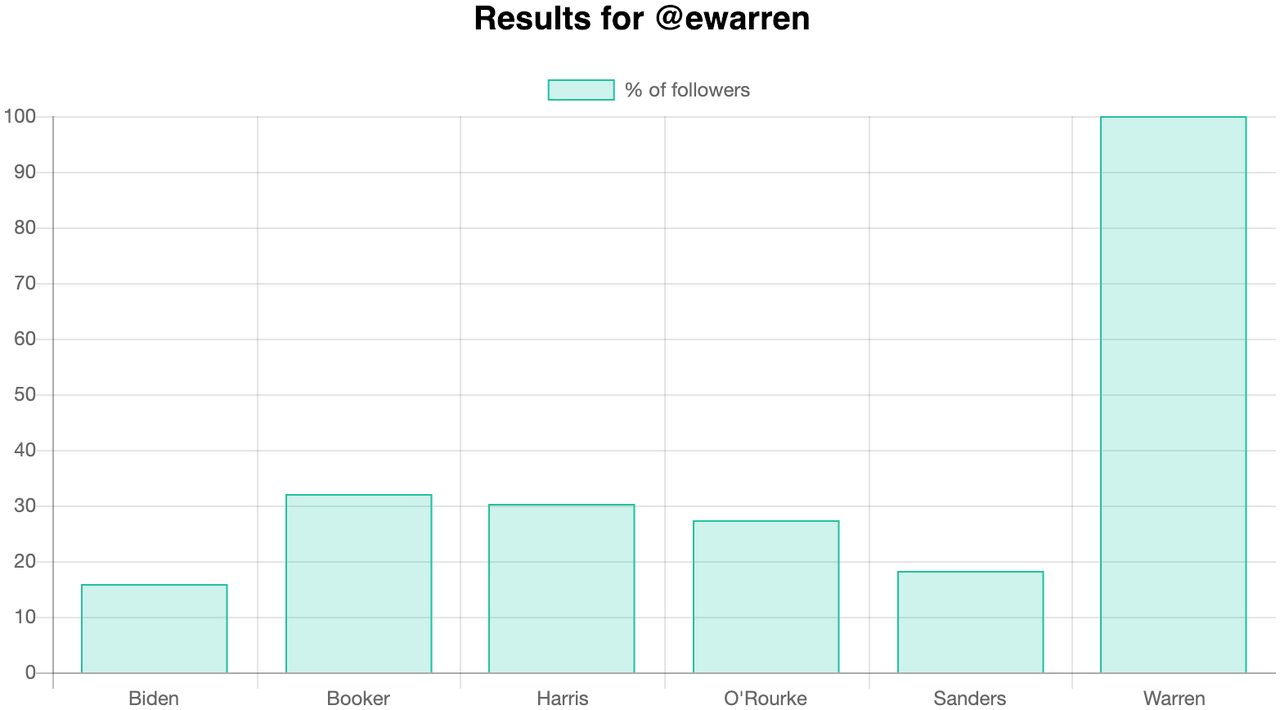
First up, here’s a look at the account for Warren ― the only one of the six who has declared she plans to run. The results for her recently renamed @ewarren account are perhaps not what you might expect. Despite her position on the progressive wing of the Democratic Party, Booker is the potential candidate in whom her followers are otherwise most interested. Booker is sometimes framed as a more corporatist or centrist Democrat, but 32 percent of Warren’s followers follow him ― while just 18 percent of Warren’s followers follow Sanders, arguably her closest ideological rival.
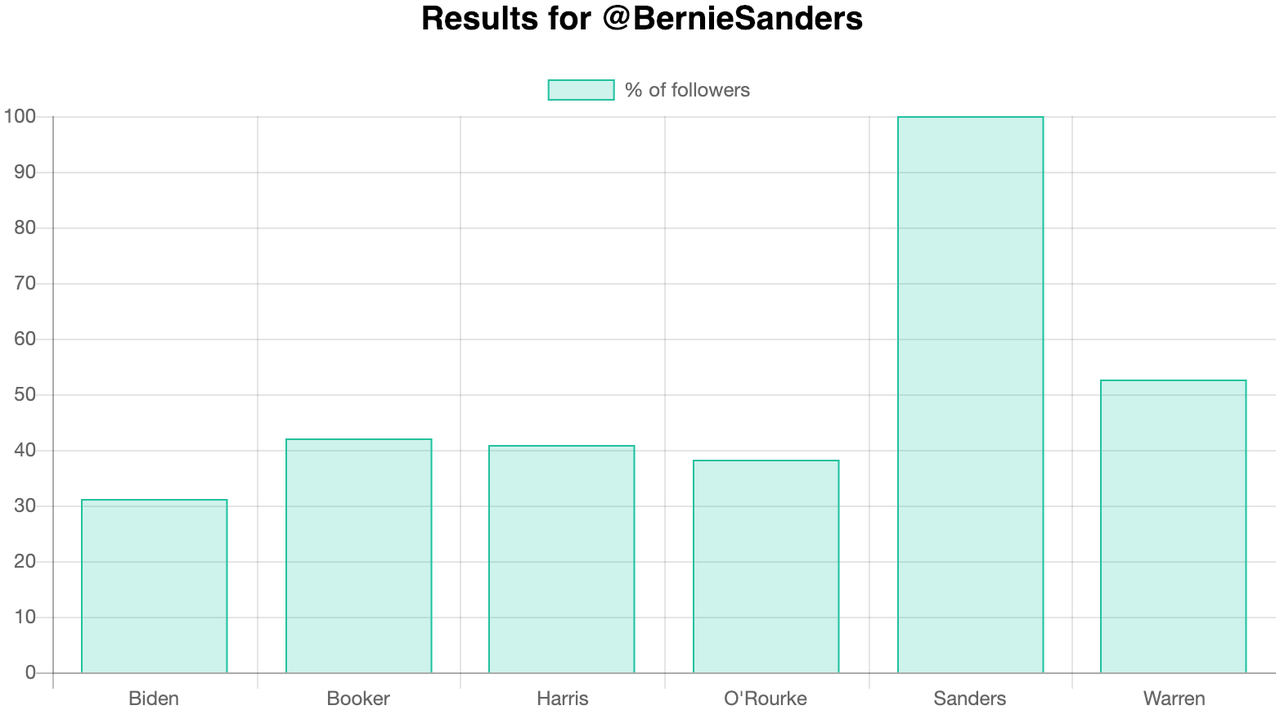
So what about Sanders himself? Warren is by some distance the other candidate that his 8.96 million followers are most interested in hearing from; 52.5 percent of his followers also follow her. Of our sample, the candidate whom Bernie followers are least interested in is Biden ― but to keep this apparent ideological distance in perspective, the former vice president is still followed by 30 percent of Sanders’ followers.
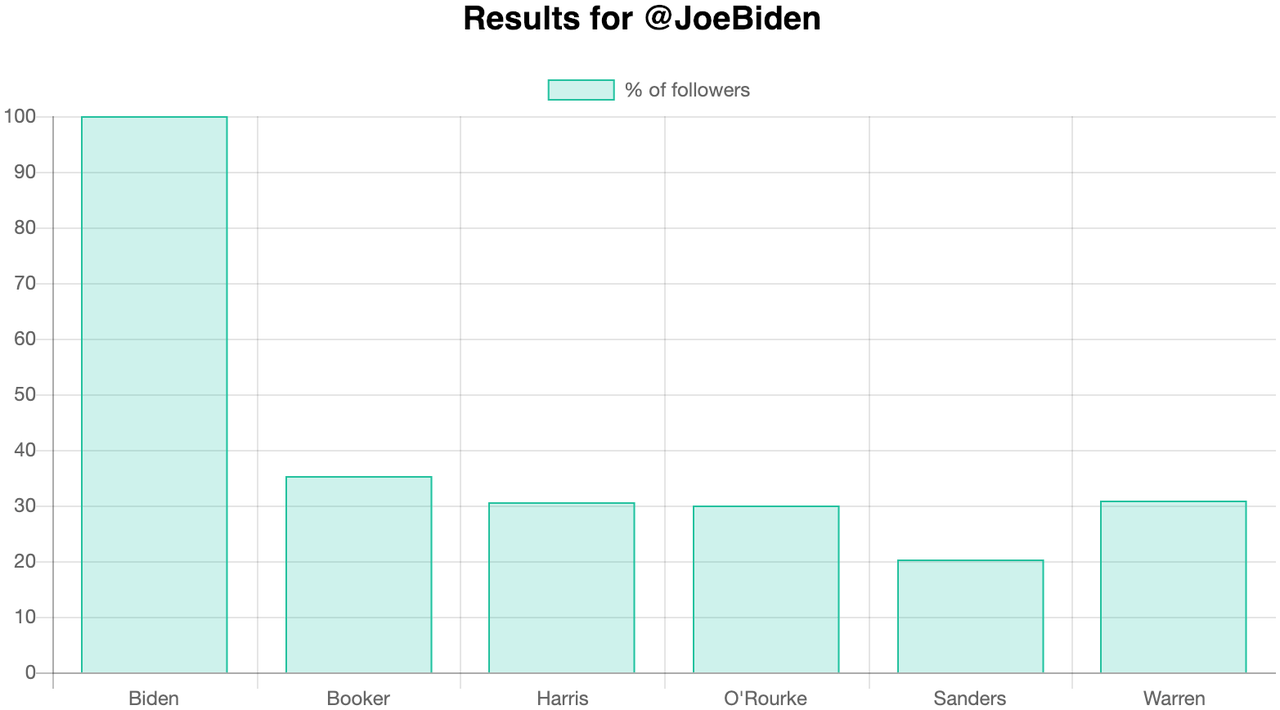
The relative disinterest in Biden, however, does appear to be mutual. According to this data, only 20 percent of his 3.2 million followers are also following Sanders.
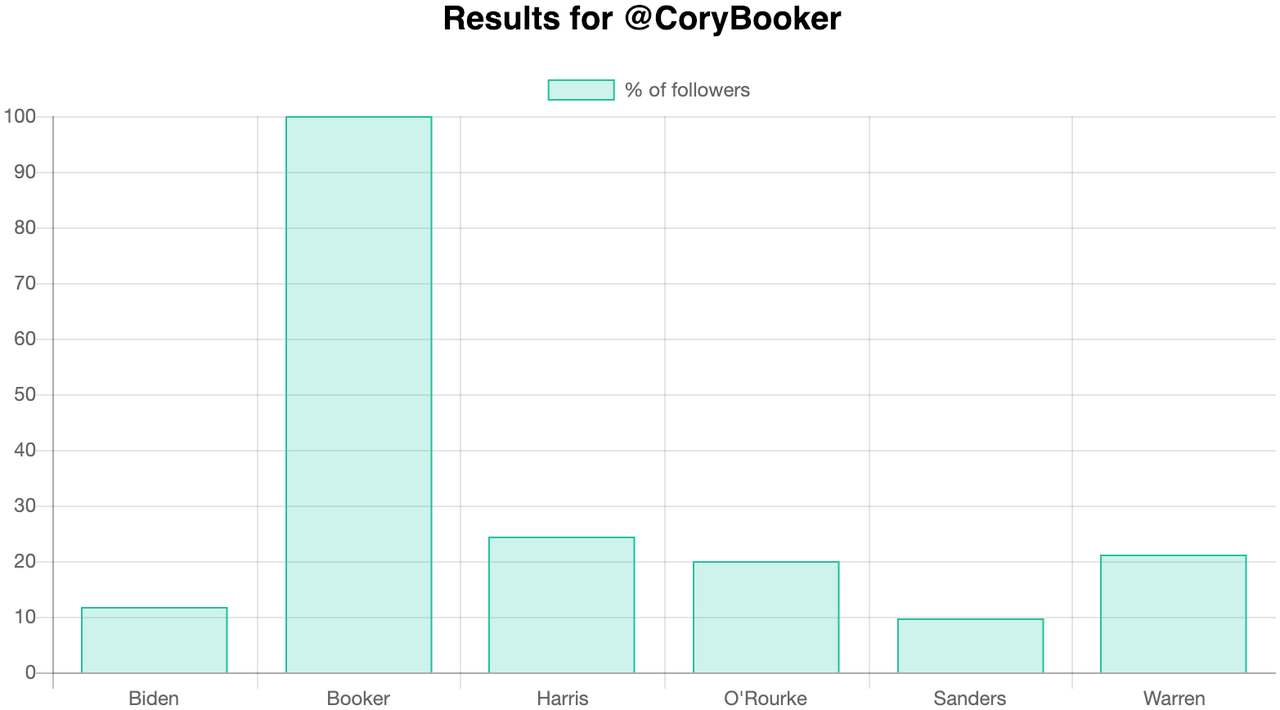
Now here’s Booker. What’s perhaps most striking is how his followers are less likely to follow the other candidates (compared to, say, Sanders). Just 24 percent of his followers also follow Harris, and she’s the other potential candidate his followers are most interested in. Sanders performs the worst, with just under 10 percent of Booker’s followers also following the Vermont senator.
This is actually pretty surprising. If we had made a guess before running the numbers, we would have guessed the opposite: Given that Sanders has a much higher profile off the back of 2016, surely he would be the candidate with the fewest mutuals? Wouldn’t many of his followers be average Americans, not nerds like us who follow lots of politicians and read detailed data analyses? But this suggests otherwise ― that Booker has forged the most “independent” Twitter footprint, compared to the other candidates. Why? We have no idea.
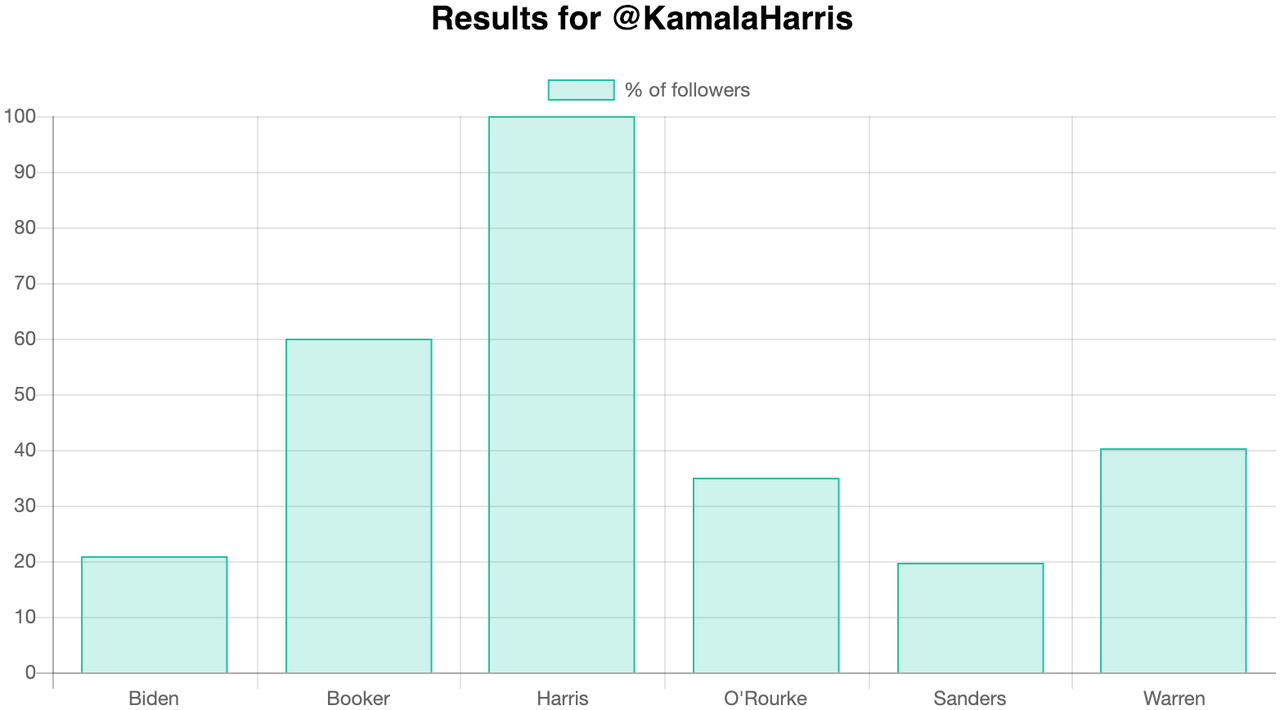
Harris is in almost the opposite situation as Booker, as she has the single biggest overlap with another potential candidate. Amazingly, 60 percent of her followers also follow Booker.
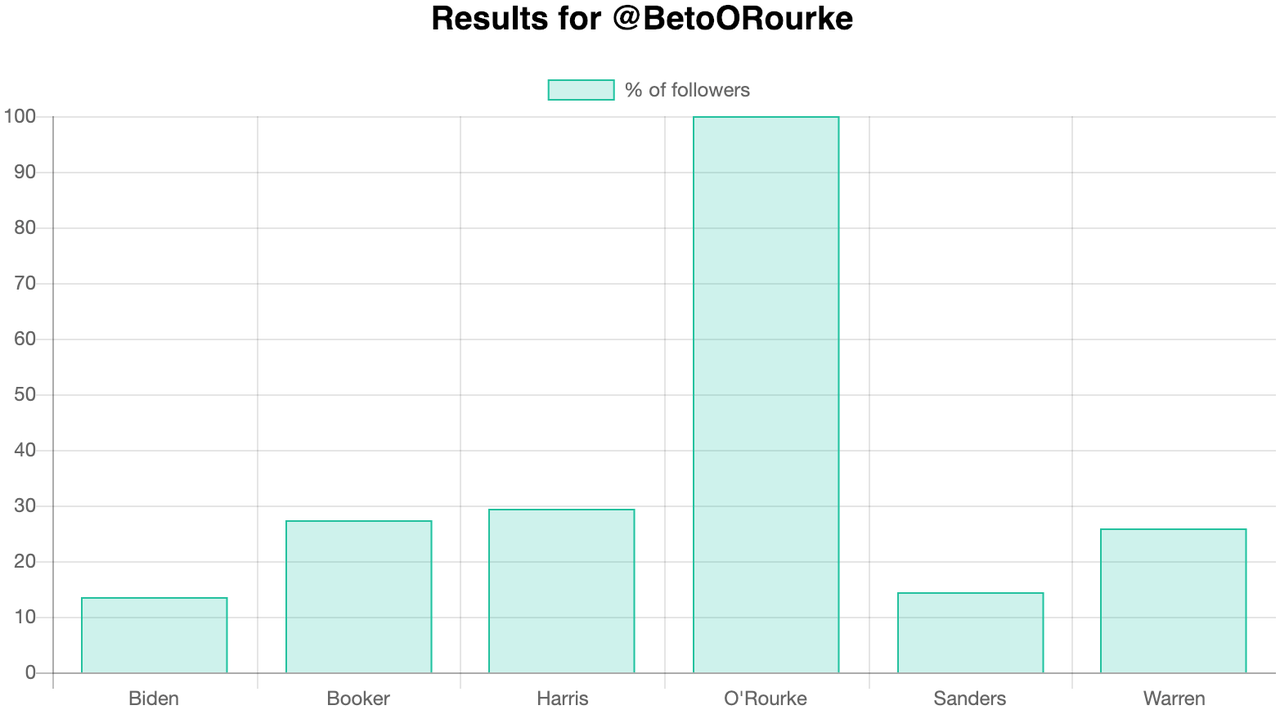
And finally, what of the Democrats’ new wunderkind, O’Rourke, who is a youthful, umm, 46 years old? His followers appear most interested in Booker, Harris and Warren, with Biden and Sanders proving less enticing. So maybe add this as fuel to the fire in the ongoing Beto/Bernie Twitter war...
Influential Voices?
We also looked at which Twitter accounts are the most popular among the followers of each of the six candidates, in hopes of giving a more detailed snapshot of which voices could conceivably influence the social media conversation during the primary.

For example, Oprah Winfrey is followed by 37 percent of Cory followers ― which arguably makes her a slightly more influential voice on “Booker Twitter” than “Beto Twitter.”

Similarly, Rachel Maddow is hugely influential in several of the potential candidates’ Twitter worlds ― a significant proportion of every candidates’ following are also following the MSNBC host. (It wouldn’t be surprising if the other candidates follow in the footsteps of Warren by heading over to Maddow’s studio for a long-form interview once they say they have plans to run.)

It’s also striking to see how many of the potential candidates’ followers follow Ocasio-Cortez, Congress’ biggest new star. Despite having only been a national figure for a few months, Twitter data suggests what is obvious in the real world: Ocasio-Cortez is well-positioned to be hugely influential in the primary. Over 50 percent of O’Rourke’s followers also follow her (and she even already has double the number of followers that he does), as do over 40 percent of the followers for both Warren and Sanders. Only Biden’s followers seem less interested in what she has to say.
This data also contains some fun surprises. For example, it turns out Sanders’ followers are most likely to follow SpaceX, even though that doesn’t make much intuitive ideological sense. Our guess that it isn’t all “Chapo Trap House” listeners looking for material to dump on Elon Musk. Instead, it’s probably more of a reflection of Sanders’ mainstream success in 2016 ― so his almost 9 million followers are perhaps more reflective of average Americans, with average interests, and not just people who read Jacobin.
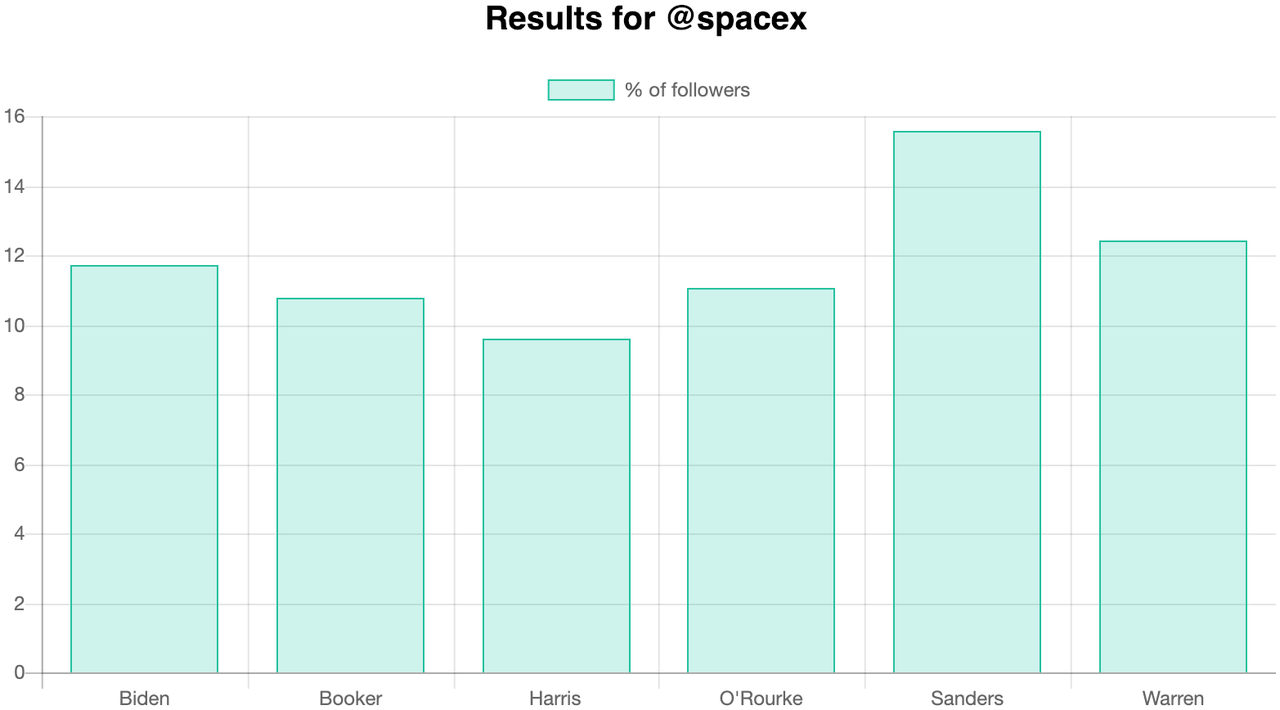
You may be wondering how O’Rourke became such a big deal so quickly. Yes, he’s an impressive candidate. But some of his rise could have something to do with the fact that almost 9 percent of his 1.2 million followers also follow “Pod Save America,” a podcast that consistently boosted him throughout his 2018 Senate campaign.
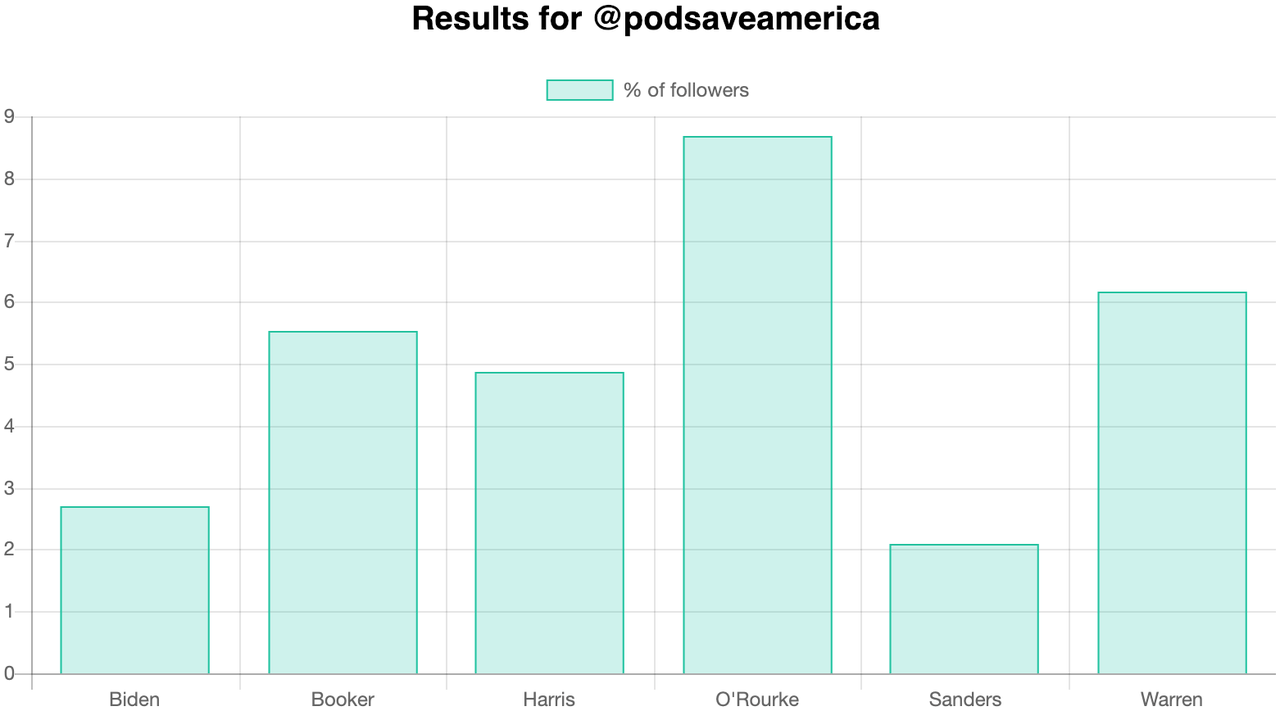
Choose Your Own Twitter Argument
Now here’s the exciting part: You can forget our wild speculation about the data above and have your own fun. We’ve built a tool to look into our data so that you can type in the name of a Twitter account, then see how popular that given account is among the followers of these six major potential candidates. There’s data for over 25,000 accounts, so knock yourselves out ― and don’t forget to tweet your most interesting finds back at us.
James O’Malley tweets as @Psythor.
